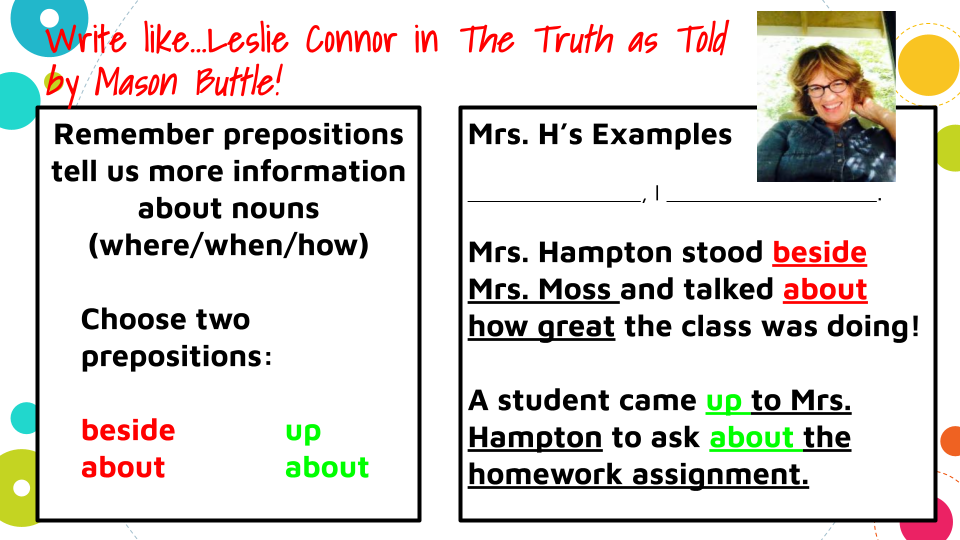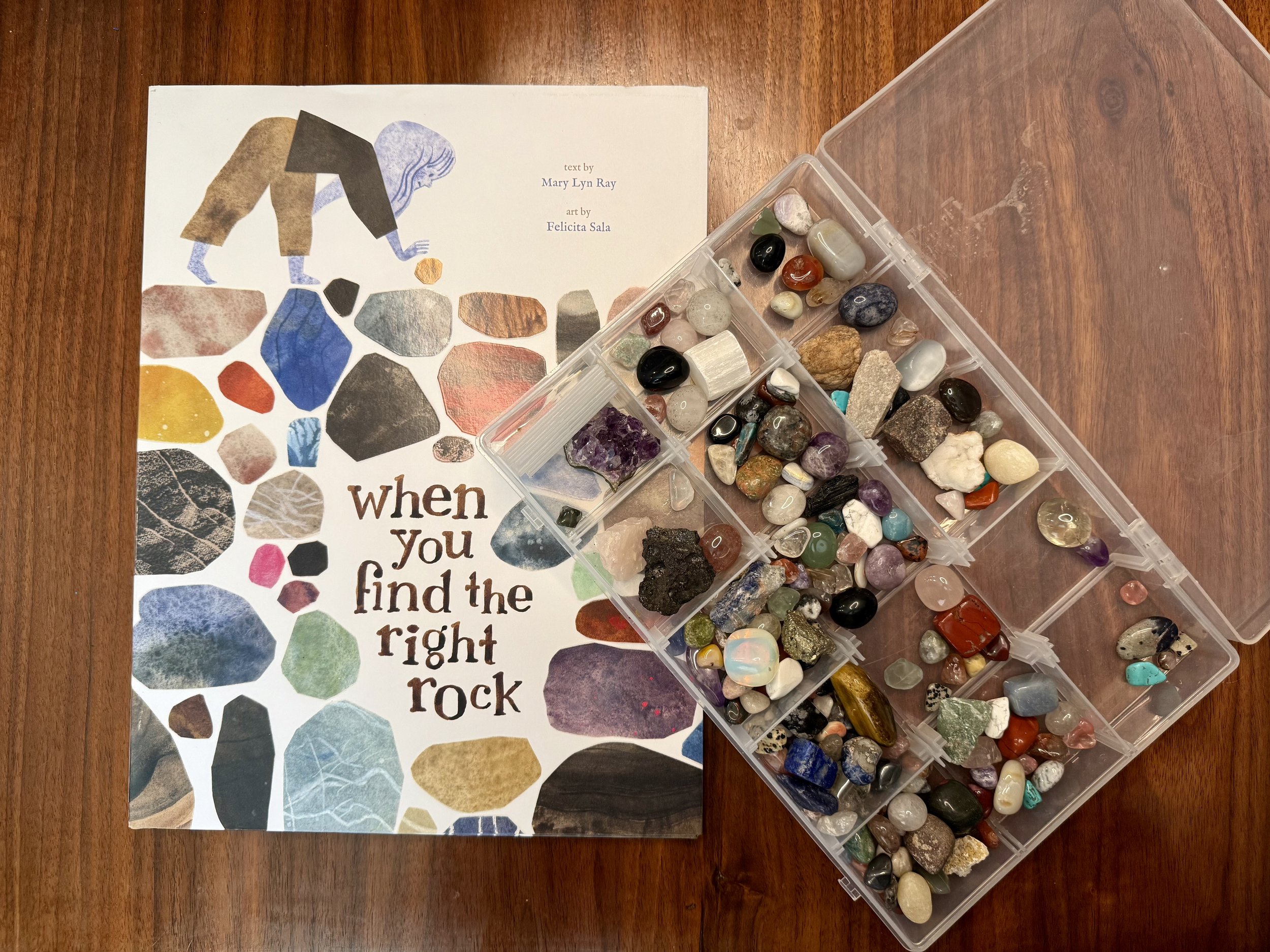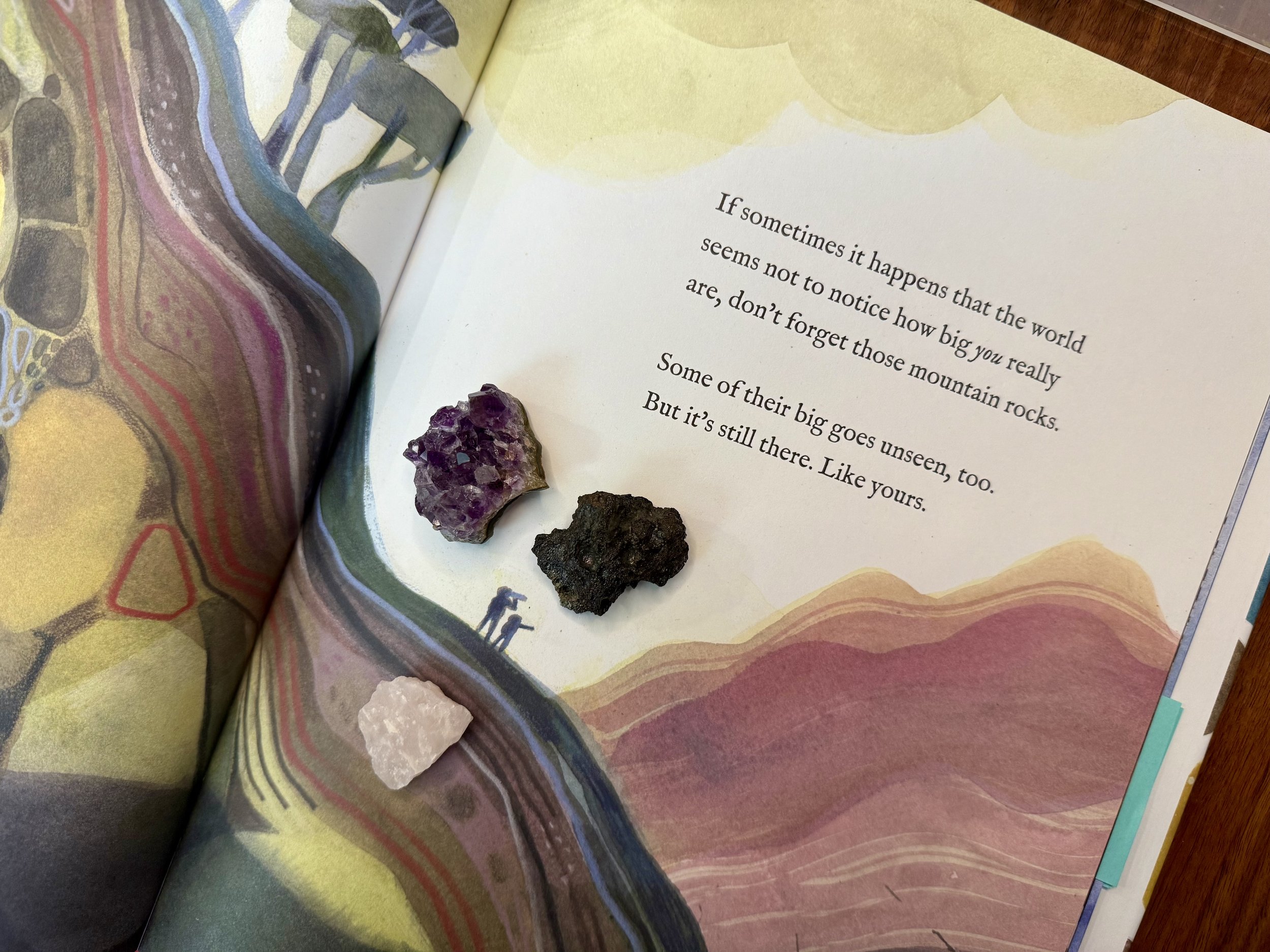When You Find the Right Rock: Journaling with Wonder, Belonging, and Connection
Disclosure: Writing Mindset only endorses things that I’ve personally used, something similar, or come highly recommended by trusted peers. If you grab anything I mention using a referral link, I may get a small commission. However, there’s no extra cost to you. If you would like to learn more, please visit the privacy policy and disclosure page.
Mary Lyn Ray and Felicita Sala’s When You Find the Right Rock is a quiet celebration of attention and belonging—of the small, ordinary things that feel extraordinary when noticed with care. Through poetic language and luminous illustrations, Ray and Sala capture the simple act of finding a rock and transform it into something magical: a story about connection, grounding, and discovery. I think one of my favorite parts of this book when reading it to our little one was pausing on lines like,
“Still, there might be times when rocks don’t seem like much to look at. But then one will surprise you—like when you notice something special about you that surprises you. Just when you were maybe feeling sort of ordinary, there it is.”
For writers and journalers, this book is a meditation on presence. It reminds us that meaning often hides in small moments—holding a smooth rock, feeling its weight, noticing its color or warmth. When You Find the Right Rock invites us to pause, look closer, and find joy in what fits just right in our hands and hearts.
In this post, you can find…
Tips for using this book as a mentor text for writing
Ways to use the book with preschoolers, grades k-5, grades 6-8, grades 9-12, and for disciplinary literacy projects
Journaling prompts linked to the book (including nature journaling)
One grammar exercise to access grammar instruction
Using When You Find the Right Rock as a Mentor Text
This book was chosen for its focus on observation, mindfulness, and connection to the natural world. Its lyrical, reflective style encourages writers to slow down and notice details, modeling descriptive language and sensory writing. It serves as a mentor text for cultivating attention to small moments, showing how everyday experiences can become meaningful material for personal or creative writing.
When reading Ray’s book, notice how she:
Uses sensory detail to evoke emotion – Texture, color, and sound bring the simple act of finding a rock to life.
Builds metaphor through observation – The rock becomes more than an object—it’s a friend, a keepsake, a piece of the earth that speaks.
Connects outer and inner worlds – What we hold in our hands reflects what we hold inside ourselves.
Blends simplicity with depth – Every line feels effortless, yet layered with wonder and tenderness.
As a mentor text, When You Find the Right Rock encourages us to explore how everyday things—stones, leaves, memories—can become metaphors for belonging and connection.
Journaling Prompt: “My Rock, My Reminder”
Open your journal and think about something small in your life that feels grounding or meaningful. It could be a rock, a shell, a piece of jewelry, a note, or even a habit or place that centers you. Then, write using one of these prompts:
“When I hold it, I remember…”
“This reminds me that I belong because…”
“My rock is like…” (use a metaphor to describe what it represents)
“The right rock for me feels like…”
You can also use this journaling activity as a sensory meditation—write about the object’s color, texture, or shape, then describe what feelings it stirs inside you.
Example:
My rock is a pocket-sized piece of calm, smooth as water and patient as time.
Why This Works
Writing through sensory experience helps us connect body and mind, presence and memory. When You Find the Right Rock teaches that wonder doesn’t need to be grand. It lives in the things we take the time to notice. Journaling this way helps us slow down and rediscover our connection to the world around us.
👉 Try it today: Step outside, find a rock that speaks to you, and write about what makes it “the right one.”
For my own writing brainstorm, I leaned on the mentor text poem “On the Pulse of Morning” by Maya Angelou. In this poem, she personifies different elements of nature—the Rock, the River, and the Tree. Focusing on the line, “The Rock cries out to us today, you may stand upon me,” I wanted to spend some time reflecting on what I stand on, specifically, the beliefs or positions I’m willing to hang my hat on. I also thought about Sarah Kay’s poem “If I Should Have a Daughter.” After rewatching it, I created a working list poem that I plan to continue developing in my own notebook.
A Working List Poem
Sit by the kid in the cafeteria who is alone.
Be kind to others.
This includes kindness to yourself, too.
Read books.
When you feel lost, go to places with books. Like the library or a bookstore.
You are a writer long before you learn to write.
Keep writing letters to mom.
I would move mountains for you.
Mom and Dad love you.
Remind yourself something that is special about you each day.
Say hello. Acknowledge each of us exist.
Remember jumping in puddles. There will always be puddles.
Don’t stop laughing.
Say thank you—even if it is not out loud.
Notice rocks along the path that stand out to you.
Don’t be afraid to be a beginner. Start over if you need to.
Remember how to play.
Your big heart is your biggest source of strength.
Your superpower is asking why.
For Educators: Bringing When You Find the Right Rock into the Classroom
Preschool Literacy Connections
Preschoolers love collecting treasures—rocks, leaves, sticks, or shells. Use this story to nurture observation and descriptive language.
After reading, take a short nature walk. Invite students to find a rock they love.
Have them describe or draw it using simple adjectives: smooth, rough, shiny, gray, warm.
Build vocabulary around textures and feelings.
Encourage sharing circles: Why is this your right rock?
Grades K–5
Elementary readers can extend this story into art, science, and writing connections.
Have students write a “rock poem” using sensory details.
Introduce basic geology concepts—different kinds of rocks, where they come from, how they change.
Create a class “rock museum,” labeling each rock with a descriptive or metaphorical name (The Friendship Rock, The Brave Rock, The Dream Rock).
Discuss the idea of belonging and connection—how small things can make us feel part of something larger.
Grades 6–8
Middle school students can explore symbolism and emotional connection.
Begin with a quick-write: “When I hold something familiar, I feel…”
Have students write a short narrative about an object that represents comfort, strength, or memory.
Discuss how Ray uses simplicity to express emotion—how restraint can make writing powerful.
Pair this activity with lessons on figurative language or personal narrative development.
Grades 9–12
For older students, When You Find the Right Rock opens discussions about memory, mindfulness, and identity.
Ask: What does it mean to find something that “fits” you?
Connect the text to journaling around personal artifacts or significant objects—something that tells part of their story.
Have students create a multimedia project: photograph their object, pair it with writing, and share it as part of a “Story of Belonging” gallery.
Use the book to explore tone and imagery in minimalist writing.
Disciplinary Literacy Connections
When You Find the Right Rock easily crosses subject areas:
Science: Explore rock types, erosion, and the rock cycle. Pair writing with observation and classification.
Art: Create texture rubbings or paint rock mandalas inspired by the illustrations.
Social Studies: Discuss places that hold personal or cultural significance—how land and belonging connect.
Math: Use rocks in measurement, sorting, and pattern-making activities. Reflect: How can something so small hold so many possibilities?
Each connection shows how noticing—through writing, art, or science—leads to deeper understanding.
Grammar Focus: Sentence-Level Craft
Skill Focus: Using Prepositional Phrases to Create Imagery
Ray often layers simple prepositional phrases to show movement and place:
Under the sky, beside the water, you find your rock.
In your hand, it feels like home.
Encourage students (or yourself) to revise a journal entry using prepositional phrases to add rhythm and sensory depth.
Here is a sample routine to teach prepositional phrases using the book, The Truth as Told by Mason Buttle by Leslie Connor.




Nature Journaling Connection
This book naturally belongs in nature journaling practice. Take a moment outdoors to look for textures, patterns, and natural objects that speak to you.
Collect one small object—a rock, a leaf, a pinecone—and write about its journey. Where might it have come from?
Sketch it, noting details like shape, color, and surface.
Write: This rock reminds me of… or I belong here because…
Through this practice, journaling becomes an act of grounding and gratitude.
Additional Journal Prompts for Wellness
Finding your “right rock” is about connection and stillness—perfect for reflection and self-care. Try these prompts:
“What helps me feel steady when life feels uncertain?”
“What small rituals or objects bring me calm?”
“If I could carry one reminder of peace, what would it be?”
“Where do I feel most grounded—in nature, at home, or with others?”
These prompts help reconnect the self to stillness and belonging—small anchors in a busy world.
Final Thought:
When You Find the Right Rock is a gentle reminder that meaning is found in the details we choose to see. Whether in journaling, teaching, or simply walking outside, this story encourages us to slow down, notice, and hold space for wonder. Sometimes, the “right rock” isn’t something we find—it’s something that finds us when we’re ready to see it.






